Waking up at the crack of dawn (or before) is surprisingly rewarding when it includes a trip to the Hawaiian Seafood Auction to experience the excitement of the auction and talk with a fleet owner and it doesn’t stop there…
5:00am and my alarm sounds. Groan. Roll-over. Try to ignore it. Then I remember, I’m in Hawaii, smile and hop out of bed.
The Hawaii Seafood Auction opens before 6am but I believe they took pity on us, allowed us some rest and met us at 6am for the tour. Guiding us was Sean Martin, co-owner of POP Fishing and Marine, a company managing six longline fishing vessels, bait shops, ice supply, liferafts, and a plethora of other fishing needs – quite an impressive list. For such a busy man, I was impressed and thankful he was willing to take two hours out of his morning to show us around.
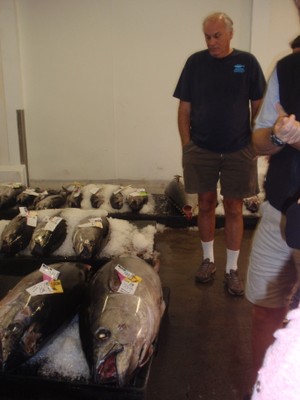
The auction was unlike anything I had ever seen. A well-orchestrated symphony of buyers, fish, workers, and onlookers, fast-paced and high-energy. I felt always in the way with the number of people in constant motion and instantly mesmerized by the action.
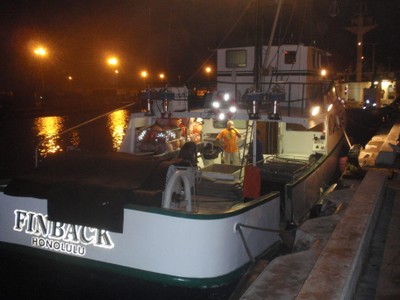
A longliner arrives at the port the night before the auction. Fish are left on the boats on ice until the next morning when fish are removed, weighed and tagged – to distinguish which boat the fish originated from, the weight and any other important details. The fish are then laid out on palettes in long rows across the floor creating aisles of traffic. We saw bigeye tuna, yellowfin tuna, oil fish, opah, marlin, swordfish, wahoo and many more.
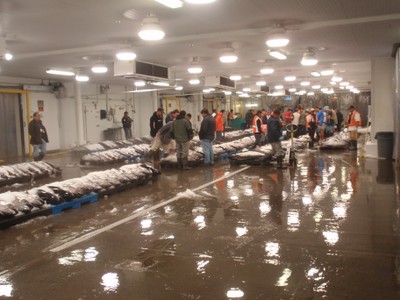
Auction workers follow the palettes down the line; the auction manager inspects the fish to determine health and a baseline of quality. Any fish he deems unfit for sale will be given back to the boat (and most likely discarded). The Hawaiian Seafood Auction takes pride in selling only the highest quality, however, low quality fish are not often seen. A man with a long metal tool takes a core of the fish and lays it on a white index card for buyers to inspect. The next man uses a large knife to slice off a chunk of the tail to expose the meat for further inspection. According to Sean, the buyers can immediately determine the quality of the fish simply by glancing at the core and the meat color.

The buyers and auctioneer move as one. In slow constant motion they work their way down the rows of fish speaking a secret language of prices and quality, unintelligible to the spectators peering over shoulders and down the line. A sale is made, the price per pound is noted, a buyer tag is printed, and everything is stapled to the original tag. By the time the tag is printed, the group has already moved on, most likely 4-5 fish ahead. Designated auction workers collect the sold fish on a palette and cart them off to the loading area where they are collected by the buyer and shipped to their final destination. One last worker scoots around sweeping the excess ice onto the grates to clear off the floor for the next batch of fish. The process repeats until all fish are sold.
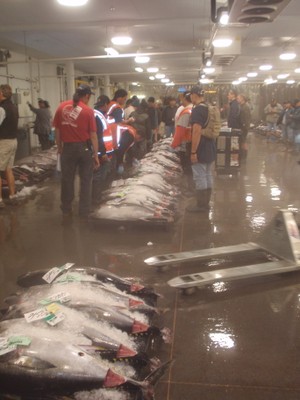
Cornering one of the assistant buyers (ok, we didn’t corner so much as strike up a conversation when he least expected it), we learned that the process did not stop once the fish left the market. He described that his buyer – an intimidating looking Hawaiian fellow – was inputting all of the bought fishes’ information into an iPad-looking machine that transferred the data to sellers back at their office. Those sellers were then using the information to sell the fish to buyers all over the US – he shared that his company sold all the fish for Iron Chef! – by 8am the fish would be on a plane to the mainland via UPS. Some auction buyers even sold to Canada!
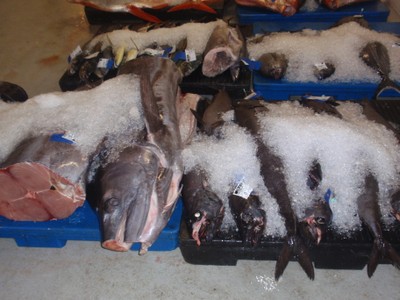
Sean then brought us outside to show us one of his “smaller” longliners. The boat is 64 ft long and serves a crew of four – one captain and three deckhands. The average time fishing is 12-14 days with 1-5 days of travel before and after. Sean told us later that the fishermen spend around 268 days a year out fishing! On a good day, boats might bring in upwards of 25,000 lbs of fish to sell and can net a pretty penny (to be split between auction charges, ship gear and maintenance costs, the ship owner and the crew).
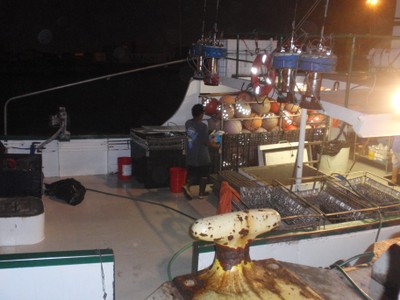
After the excitement of the auction we settled down and trekked over to NOAA’s Pacific Island Regional Office (PIRO) to meet with former CEMs and other office members. We discussed current issues amongst sea turtles, false killer whales, 83 proposed endangered coral species and spinner dolphins. Overall, an interesting conversation and educational on the applied process of the Endangered Species Act and current Hawaiian issues.
We rounded out the day by enjoying lunch and dinner with Charles Littnan (can never get enough of the Honey Badger) and CEM alums. The discussion, of course, turned to monk seals and conservation issues in Hawaii. The last comment of the night from former CEM, Elia Herman, “I think about Midway everyday; Midway will change your life.”
Tomorrow, we’ll experience that change.

Aloha everyone! I’ve loved the blogs for the past few days, thanks Caitlyn, Dani and Greg (and thanks in advance to everyone else). I think, rather I know, I am living vicariously through all of you right this very second. And Elia is totally right, Midway will change your life 🙂 Take advantage of every second you have there and take lots of photos. Say hi to everyone and everything on Midway for me (and probably for the rest of the CEM Midway Alum too)!
Impressive as always! I think I could almost smell the fish. Sounds like you are having a great time and learning so much. Thanks for sharing.
I really enjoyed reading about your experience at the fish auction. You painted a visual image with your words.